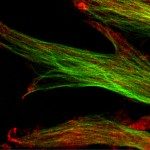Link to Pubmed [PMID] – 40033850
Link to DOI – 10.1111/febs.70001
FEBS J 2025 Mar; ():
SprA1 and SprA2 are small hydrophobic peptides that belong to the type I toxin-antitoxin systems expressed by Staphylococcus aureus. Both peptides induce S. aureus death when overexpressed. Although they share 71% of amino acids sequence similarity, SprA2 exhibits stronger hemolytic activity than SprA1. In this study, we investigated the mode of action of these toxins on both prokaryotic-like and eukaryotic-like membranes. We first confirmed that SprA2, like SprA1, is an alpha-helical peptide located at the S. aureus membrane. By overexpressing each toxin, we demonstrated that SprA1 forms stable pores in the S. aureus membrane, evidenced by concomitant membrane depolarization, permeabilization and ATP release leading to growth arrest, whereas SprA2 forms transient pores, causing concomitant membrane depolarization, ATP release, and growth arrest. We showed that the unique cysteine residue present in SprA1 and SprA2 is required for toxicity through disulfide bond formation. Next, we found that both synthetic peptides induce slight leakage in anionic DOPC-DOPG lipid vesicles mimicking prokaryotic membranes, concomitant with lipid vesicles aggregation and/or fusion. Moreover, we observed that SprA1 permeabilizes S. aureus protoplasts, via its ability to form stable pores, whereas SprA2 permeabilizes and lyses them. However, no permeabilization of intact bacteria was detected after the addition of SprA1 and SprA2 in the extracellular medium. Finally, we confirmed that SprA2 has strong activity on zwitterionic DOPC lipid vesicles mimicking eukaryotic membranes, without inducing aggregation. This work highlights the strong selectivity of SprA2 for eukaryotic membranes, suggesting that this toxin may play a role in S. aureus virulence.

